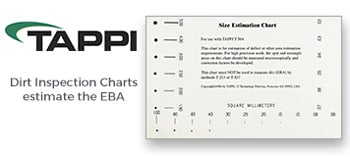 Search
Search
Use the search bar or filters below to find any TAPPI product or publication.
Filters
Content Type
Publications
Level of Knowledge
Committees
Collections
Magazine articles

Corrosion in lower furnace of kraft recovery boilersâ??in-situ characterization of corrosive environments, Solutions! & TAPPI JOURNAL, February 2004, Vol. 3(2) (179KB)
Corrosion in lower furnace of kraft recovery boilers–in-situ characterization of corrosive environments, Solutions! & TAPPI JOURNAL, February 2004, Vol. 3(2) (179KB)
Magazine articles

Treatment efficiency of eucalypt kraft pulp bleaching effluents: influence of dissolved organic matter, SOLUTIONS! & TAPPI JOURNAL, April 2002 (128KB)
Treatment efficiency of eucalypt kraft pulp bleaching effluents: influence of dissolved organic matter, SOLUTIONS! & TAPPI JOURNAL, April 2002 (128KB)
Journal articles

Magazine articles

Low consistency refining of mechanical pulp — system design
Low consistency refining of mechanical pulp — system design, TAPPI JOURNAL July 2017
Journal articles

Magazine articles

Improving refining efficiency with deflocculation, TAPPI Journal May 2022
ABSTRACT: The ability to load a refiner requires the formation of a fiber mat between opposing refiner bars. One of the consequences of this is the formation of flocs that persist through the refiner grooves and exit the refiner. These flocs interfere with sheet strength, requiring additional energy to make up the strength deficit. In addition, flocs can initiate string formation, resulting in machine efficiency issues such as cross-machine profile deterioration and the downtime required to correct it. Novel refiner plate modifications have been shown to improve refining efficiency in otherwise identical refiner plates. Energy savings are typically around 15% of gross refining energy on the basis of the treated stock, although much higher reductions have also been seen. Addressing this previously underappreciated flaw in conventional refining enables greenhouse gas reduction and other benefits related to sheet strength and machine efficiency.
Journal articles

Magazine articles

Fiber-based characterization of pulp refining, TAPPI Journal September 2022
ABSTRACT: Fiber development in pulp refining can be characterized by three parameters: number of impacts on pulp, N; energy per impact, I, and bar force on fibers, F. These parameters enable comparisons of radically different refining conditions; determination of intensity for hardwoods and softwoods; assessment of effect of bar width on fiber shortening; and predictions of tensile strength increases.
Journal articles

Magazine articles

Compression refining: the future of refining? Application to Nordic bleached softwood kraft pulp, TAPPI Journal August 2024
ABSTRACT: A new compression refining technology based on the kneading of high consistency pulp has been selected and tested in various conditions with a model Nordic bleached softwood kraft (NBSK) pulp. The method uses a kneader mixer referred to as the ultra continuous mixer (UCM) to condition the pulp. Its performance levels were also compared with those obtained with traditional low consistency (LC) refining of the same pulp.Compression refining of the NBSK pulp with the UCM led to a much better °SR/strength compromise than conventional LC refining. High strength properties can also be achieved by compression refining, in a range similar to/or better than LC refining. The higher the strength required, the greater the advantages of this technology: for a given strength, a difference of up to 10°SR can be obtained as compared to LC refined pulp. Moreover, a higher tear index can be obtained with compression refining, since fiber cutting is greatly reduced.The lower °SR is due to the release of fewer cellulosic fines, which also results in the manufacturing of new papers combining a high strength and a high permeability that cannot be obtained with traditional LC refining. Indeed, with LC refining, a high strength is generally associated with a low permeability. Upscaling this technology seems to be possible since large production devices are already on the market for applications other than paper/pulp. With this new pulp behavior, papermakers will have to learn to think differently, as paper strength and °SR can now be decorrelated.
Journal articles

Magazine articles

Flow rheology of light foams generated from aqueous solutions of polyvinyl alcohol, TAPPI Journal January 2023
ABSTRACT: Recent studies have shown that foam-assisted application of additives into a wet web has advantages over the conventional way of adding the chemicals into the pulp suspension before forming, e.g., increased mechanical retention as well as high dosage giving increased wet strength without impairing the sheet uniformity. To engineer processes utilizing this new technology, the complex flow behavior of applied foams must be quantified. At the minimum, the foam viscosity and the slip velocity at the solid surfaces need to be known to build practical models that can be used in analyzing and upscaling unit processes of the foam-assisted application.In this study, the rheological behavior was quantified for foams having polyvinyl alcohol (PVOH), a widely used strength additive chemical, as the surfactant. The foam density was varied between 100 g/L and 300 g/L, and the concentration of the PVOH solution was varied between 0.5% and 6.0% (w/w). The foams were generated with a commercial foam generator, and the rheological properties of the foams were measured by using a horizontal pipe bank. At the outlet from the generator, the volumetric flow rate, the absolute pressure, and the bubble size distribution of the foam were measured. In the measurement pipe section, the viscous pressure gradient and the slip velocity were measured, after which the foam was discharged to ambient air pressure. The viscosity and the dynamic surface tension of the PVOH solutions were quantified with commercial laboratory devices. In the viscosity analysis, the apparent shear rate was calculated from the volumetric flow rate, and the resulting apparent viscosity was translated to real material viscosity data by applying the Weissenberg-Rabinowitsch correction. The results indicated that PVOH foams can be described with high accuracy as shear-thinning power-law fluids where the detailed behavior depends on the foam density and the PVOH concentration. Slip flow, as usual, increased with increasing wall shear stress, but it was also dependent on the PVOH concentration, the air content, and the bubble size. For both the foam viscosity and the slip flow, a correlation was found that described the quantitative behavior of all the studied foams with good accuracy.
Journal articles

Magazine articles

Effect of pH and enzymes on strength of recycled fibers during refining, TAPPI JOURNAL July 2018
Effect of pH and enzymes on strength of recycled fibers during refining, TAPPI JOURNAL July 2018
Journal articles

Magazine articles

Characterizing rheological behavior and fluidization of highly refined furnishes, TAPPI Journal April 2024
ABSTRACT: In this work, highly refined softwood bleached kraft pulp (SWBKP) furnishes, referred to here as XFC, were studied from the perspective of fiber suspension handling in processing. The rheology of the furnishes was studied with a rotational rheometer using a non-standard flow geometry to understand the viscosity development at different consistencies and the impact of temperature. For fluidization analysis during pipe flow, two optical methods were implemented; namely, optical coherence tomography (OCT) and high-speed video (HSV) imaging. The OCT was used to determine the small-scale floc structures near the pipe wall where the shear stress is highest, and the HSV imaging was applied for observing flow instabilities and XFC suspension uniformity at the pipe scale. All these issues can be significant in deciding the minimum flow rate required for a process pipe to get sufficient fluidization of XFC suspensions.
Magazine articles

Forklift emissions - some solutions, TAPPI JOURNAL, December 1993, Vol. 76(12)
Forklift emissions - some solutions, TAPPI JOURNAL, December 1993, Vol. 76(12)





